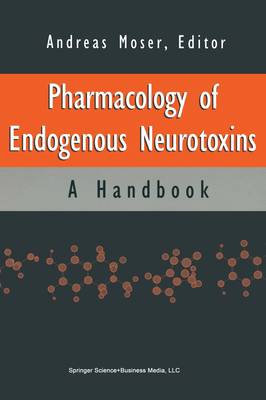
- Afhalen na 1 uur in een winkel met voorraad
- Gratis thuislevering in België vanaf € 30
- Ruim aanbod met 7 miljoen producten
- Afhalen na 1 uur in een winkel met voorraad
- Gratis thuislevering in België vanaf € 30
- Ruim aanbod met 7 miljoen producten
Zoeken
€ 151,45
+ 302 punten
Omschrijving
A Neurotoxins.- 1 Isoquinoline Derivatives.- 1. Introduction.- 2. Tetrahydroisoquinoline (TIQ).- 2.1 Presence of TIQ in nature and in food.- 2.2 Methods for identification and measurement of TIQ.- 2.3 Presence of TIQ in tissues.- 2.4 Endogenous synthesis of TIQ.- 2.5 Parkinsonism caused by TIQ.- 2.6 Metabolism of TIQ in the brain.- 3. 1,2-Dihydroisoquinoline.- 4. 4-Hydroxy-TIQ.- 5. 1-Benzyl-TIQ.- 6. 1-Phenyl-N-methyl-TIQ and 1-phenyl-TIQ.- 7. Salsolinol (SAL).- 7.1 Presence of SAL in tissues, body fluids, food, and nature.- 7.2 Biosynthetic pathway of SAL.- 7.3 Neurotoxicity of SAL.- 7.4 Metabolism of SAL.- 8. Norsalsolinol.- 9. N-Methyl-salsolinol and N-methyl-norsalsolinol.- 10. 1,2,3,4-Tetrahydro-2-methyl-4,6,7-i soquinolinetriol.- 11. Methods for identification and measurement of catecholic TIQs.- 12. The sites of toxicological activity.- 12.1 Inhibition of mitochondrial respiratory enzymes.- 12.2 Hydroxyl radical formation.- 2 TIQ Derivatives in the Human Central Nervous System.- 1. History of the Presence of TIQ derivatives.- 2. Analytical Methods.- 2.1 Cerebrospinal Fluid (CSF).- 2.1.1 Lumbar Puncture.- 2.1.2 High Performance Liquid Chromatography.- 2.2 Urine.- 2.2.1 Urine measurements of Salsolinol.- 2.2.2 Affinity chromatography.- 2.2.3 High Performance Liquid Chromatography.- 3. Frequency and TIQ Levels measured by HPLC-ECD.- 3.1 N-Methyl-norsalsolinol.- 3.2 Salsolinol.- 4. TIQ Derivatives and Dopamine Metabolites.- 5. Stereospecifity and Enantiomeric Separation.- 6. Cerebral Lesions by TIQ Derivatives.- 6.1 TIQ, 1-Methyl-TIQ, 2-Methyl-TIQ.- 6.2 N-Methyl-[R]-salsolinol.- 6.3 N-Methyl-norsalsolinol.- 6.4 N-Methyl-4-hydroxy-norsalsolinol.- 7. Hallucinosis and TIQ Derivatives.- 3 Animal Model of Parkinson's Disease Prepared by N-Methyl-R-Salsolinol.- 1. MPTP and N-Methylation.- 2. Preparation of a rat model of Parkinson's disease.- 2.1 Materials.- 2.2 Animal experiments.- 3. Behavior observation.- 3.1 Behavior changes due to perturbation in dopaminergic system.- 4. Biochemical analysis in the brain.- 4.1 Methods.- 4.2 Quantitative analyses of monoamines, their metabolites and isoquinolines.- 4.3 Enantiomeric analysis of salsolinol derivatives.- 4.4 Assay of tyrosine hydroxylase activity.- 4.5 Biochemical changes by infusion of N-methyl-[R]-salsolinol and DMDHIQ+.- 4.6 Changes of monoamines and their metabolites.- 4.7 Accumulation of N-methyl-[R]-salsolinol and DMDHIQ+.- 4.8 Reduction of tyrosine hydroxylase activity.- 5. Histological study.- 5.1 Methods for histological analysis.- 5.2 Cytotoxicity in the striatum.- 5.3 Depletion of dopamine neurons in the substantia nigra.- 6. Discussion.- 4 Putative Endogenous Neurotoxins Derived from the Biogenic Amine Neurotransmitters.- 1. Introduction.- 2. Alzheimer's disease.- 3. Ischemia-Reperfusion.- 4. Methamphetamine.- 5. In vitro oxidation chemistry of the biogenic amine neurotransmitter.- 5.1 In vitro oxidation chemistry of 5-hydroxytryptamine.- 5.2 In vitro oxidation chemistry of dopamine.- 5.3 In vitro oxidation chemistry of norepinephrine.- 6. In vivo oxidation chemistry of the biogenic amine neurotransmitter.- 6.1 In vivo oxidation of 5-hydroxytryptamine.- 6.2 In vivo oxidation of dopamine and norepinephrine.- 7. Properties of putative aberrant oxidative metabolites of the biogenic amine neurotransmitters.- 7.1 Redox properties of putative aberrant oxidative metabolites of 5-HT and 5-HTPP.- 7.2 Redox properties of putative aberrant oxidative metabolites of DA and NE.- 8. Neurochemical and neurobiological properties of putative aberrant oxidative metabolites of 5-HT, DA and NE.- 9. Serotonin binding proteins.- 10. Discussion.- 11. Summary.- 5 ?-Carboline Derivatives as Neurotoxins.- 1. Biosynthetic and organic synthetic routes to TH?C's and ?C's.- 2. Overview of the effects of ?C's and their metabolic derivatives on the nervous system.- 3. Measurement and analysis of TH?C's, ?C's and their derivatives.- 4. Enzymatic formation of N-methylated ?C cations from nonpolar ?C...
Specificaties
Betrokkenen
- Auteur(s):
- Uitgeverij:
Inhoud
- Aantal bladzijden:
- 296
- Taal:
- Engels
Eigenschappen
- Productcode (EAN):
- 9780817639938
- Verschijningsdatum:
- 18/12/1997
- Uitvoering:
- Hardcover
- Formaat:
- Genaaid
- Afmetingen:
- 178 mm x 254 mm
- Gewicht:
- 730 g

Alleen bij Standaard Boekhandel
+ 302 punten op je klantenkaart van Standaard Boekhandel
Beoordelingen
We publiceren alleen reviews die voldoen aan de voorwaarden voor reviews. Bekijk onze voorwaarden voor reviews.








